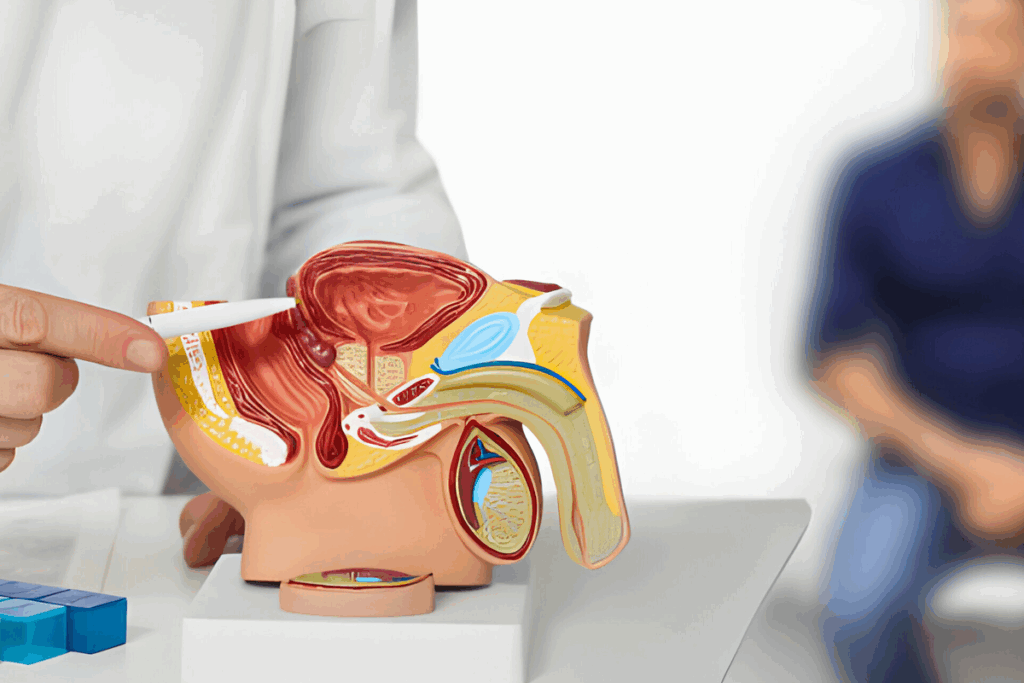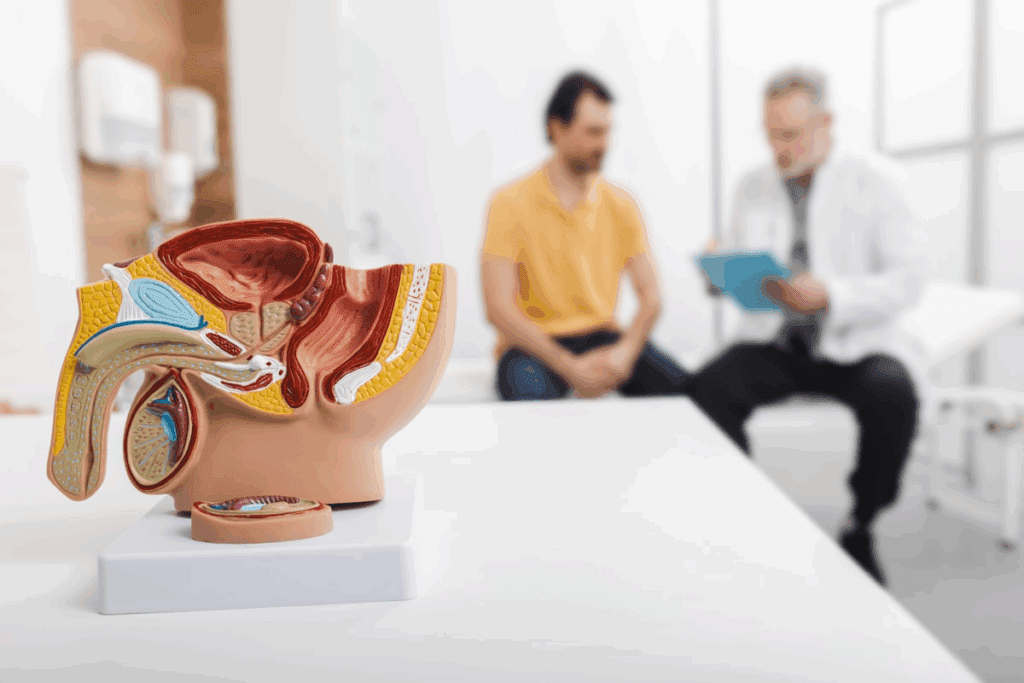Last Updated on November 25, 2025 by Ugurkan Demir

View 8 informative BPH picture examples. Understand enlarged prostate with key facts about the condition and its visual characteristics.
Understanding Benign Prostatic Hyperplasia (BPH) is key for men’s health, as they get older.
Enlarged prostate, or BPH, is when the prostate gland gets bigger. This can lead to urinary symptoms. It’s important to know the signs and the treatment choices.
Benign Prostatic Hyperplasia (BPH) is a non-cancerous growth of the prostate gland. It affects millions of men globally. As men get older, the chance of getting BPH goes up.
This condition makes the prostate gland bigger. It leads to symptoms like weak urine flow and needing to pee a lot. These symptoms can also happen at night.
By the time men reach 60, about half of them will have BPH. Knowing about BPH’s causes, symptoms, and treatments is key. It helps manage the condition and improves life quality.
There are many ways to treat BPH. Simple changes in lifestyle can help. This includes eating right and staying active. Medications like alpha-blockers and 5-alpha-reductase inhibitors can also work well.

The prostate gland is a small, walnut-sized gland. It plays a key role in the male reproductive system.
It’s located just below the bladder. The prostate gland surrounds the urethra. It’s responsible for producing fluids that make up semen.
Benign Prostatic Hyperplasia (BPH) is a condition where the prostate gland becomes enlarged. This puts pressure on the urethra and affects urine flow.
Understanding the anatomy of the prostate gland is essential. It helps us understand BPH and its symptoms.

An enlarged prostate can cause many urinary symptoms. These symptoms can really affect your daily life. It’s important to know these symptoms to get the right medical care.
One main symptom is needing to urinate often, even at night. This can mess up your sleep and daily plans.
Men with BPH might find it hard to fully empty their bladder. They might have a weak or interrupted urine flow.
Other symptoms include feeling the urgent need to urinate and dribbling after you finish. These symptoms can really lower your quality of life. It’s key to see a doctor.
If you’re dealing with these symptoms, seeing a healthcare professional is a must. They can help with the right diagnosis and treatment.
Benign Prostatic Hyperplasia (BPH) is when the prostate gland gets bigger. This gland is around the urethra and is key to the male reproductive system.
The image shows how a normal prostate looks compared to one that’s enlarged. Knowing these differences helps doctors diagnose and treat BPH.
If you’re feeling symptoms, it’s important to see a healthcare professional.
Benign Prostatic Hyperplasia (BPH) makes the prostate gland grow bigger. This can cause trouble with urination and other issues. Ultrasound and MRI are key in spotting and treating BPH.
These tools help doctors see the prostate and how bad the BPH is. They look at the size and shape to figure out the best treatment.
Getting the right diagnosis is vital for treating BPH well. Cross-sectional imaging lets doctors see the prostate’s size and shape. They can spot problems and plan a treatment just for you.
Using these imaging methods in BPH care has many benefits. It leads to better diagnosis, more personalized treatment, and better results for patients.
As men get older, the chance of getting Benign Prostatic Hyperplasia (BPH) goes up. This leads to urinary symptoms that can really affect life quality. One big problem with BPH is it presses on the urethra, making it hard to pee.
This pressure can cause symptoms like a weak pee stream, needing to pee a lot, and trouble starting or stopping pee. The enlarged prostate puts pressure on the urethra, making it hard to pee well. This can lead to a weak pee stream, making it hard to empty the bladder fully.
Managing BPH symptoms is key to avoid problems and improve life quality. There are many ways to treat it, like changing diet and exercise, or using medicine and surgery.
Knowing how BPH affects pee flow helps men manage their symptoms and avoid problems. They should watch for signs like a weak pee stream, needing to pee a lot, and waking up to pee at night. If these symptoms don’t go away or get worse, they should see a doctor.
Ultrasound imaging is key in diagnosing Benign Prostatic Hyperplasia (BPH). It helps doctors see the prostate gland’s size and shape. This info is important for making treatment plans.
Ultrasound is great for BPH diagnosis because it’s safe and works well. It gives precise measurements of the prostate. This data is essential for figuring out how severe BPH is.
Doctors look at ultrasound images for signs of BPH. They check for an enlarged prostate and any texture changes. These signs help doctors understand if BPH or other issues are present.
MRI has changed how we diagnose enlarged prostate. It gives us detailed images that help tell BPH apart from other prostate issues. We’ll see how MRI gives a full view of the prostate, helping doctors diagnose and plan treatments.
Advanced imaging, like MRI, is key for diagnosing BPH. MRI shows the prostate gland in high detail. This lets doctors accurately measure its size and shape. Knowing this helps them figure out how severe BPH is and what treatment to use.
MRI is great at telling BPH apart from other prostate problems, like cancer. It shows the prostate’s details clearly. This helps doctors spot BPH’s signs, like a bigger transition zone, and tell it apart from other issues.
| Imaging Technique | Advantages | Limitations |
| MRI | High-resolution images, excellent soft tissue contrast | High cost, limited availability |
| Ultrasound | Low cost, wide availability, real-time imaging | Limited detail, operator-dependent |
| CT Scan | Fast, good for detecting calcifications | Radiation exposure, limited soft tissue contrast |
Knowing the prostate’s anatomy is key for diagnosing and treating BPH. MRI gives a detailed look, helping doctors understand the prostate’s condition better.
Benign Prostatic Hyperplasia (BPH) makes the prostate gland grow bigger. This growth causes problems with urination. The changes seen in BPH include more glandular parts and stroma.
The changes in BPH are complex. Normally, the prostate has acinar structures and some stroma. But in BPH, these parts grow too much. This leads to the formation of nodules.
| Characteristics | Normal Prostate | BPH |
| Glandular Structure | Normal acinar structure | Hyperplastic changes |
| Stromal Component | Minimal stroma | Significant stromal proliferation |
The treatment of Benign Prostatic Hyperplasia has changed a lot. Now, patients have many choices beyond old surgery methods. It’s key to know the good and bad of each treatment.
Surgery is a big part of treating BPH, mainly for serious cases. Transurethral Resection of the Prostate (TURP) is a common surgery. It removes parts of the prostate to help urine flow better. TURP has been a top choice for many, giving big relief to those with bad BPH. Other surgeries include open prostatectomy for big prostates and simple prostatectomy.
New, less invasive methods are becoming more popular. They work well and you recover faster than with old surgery. UroLift and laser treatments, like HoLEP, are good for quick relief and less risk of problems. UroLift lifts or removes tissue without cutting the prostate, giving fast relief. These are great for those wanting to get back to life quickly and avoid big risks.
These treatments have many benefits:
Looking at these treatments, we see BPH management has many options. This gives hope and relief to men with enlarged prostates. Knowing these choices helps patients and doctors find the best treatment together.
Benign Prostatic Hyperplasia (BPH) is a common issue for many men, mainly as they get older. It’s important to know about its causes, symptoms, and treatment options. This knowledge helps keep quality of life high. Early detection and the right treatment can make a big difference.
Men can lower their risk of BPH complications by staying informed and proactive. Regular visits to healthcare providers are key for catching BPH early and managing it well.
Handling BPH well means making lifestyle changes, getting medical help, and keeping an eye on it. This approach is essential for effective management.
Benign Prostatic Hyperplasia (BPH) is a non-cancerous enlargement of the prostate gland. It affects many men as they age.
Symptoms include frequent urination, weak urine flow, and trouble starting or stopping urination.
Doctors use a physical exam, medical history, and tests like ultrasound and PSA tests to diagnose BPH.
Treatments include lifestyle changes, medications, and surgery. The choice depends on symptom severity and quality of life impact.
A normal prostate is small and doesn’t block urine flow. An enlarged prostate can press on the urethra, causing symptoms.
BPH can make the bladder overactive, leading to frequent urination. It can also damage the bladder over time.
Yes, mild BPH can be managed with lifestyle changes and medications. Severe cases may need surgery.
Untreated BPH can cause urinary retention, kidney damage, and bladder damage.
While prevention is not guaranteed, a healthy lifestyle can reduce BPH risk. This includes a balanced diet and regular exercise.
Medical attention can ease symptoms, prevent complications, and improve quality of life.
National Center for Biotechnology Information. (2025). BPH Images 8 Pictures and Facts About Enlarged. Retrieved from https://www.ncbi.nlm.nih.gov/pmc/articles/PMC5717991/
Subscribe to our e-newsletter to stay informed about the latest innovations in the world of health and exclusive offers!